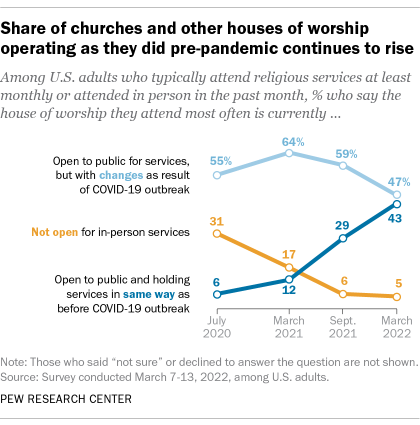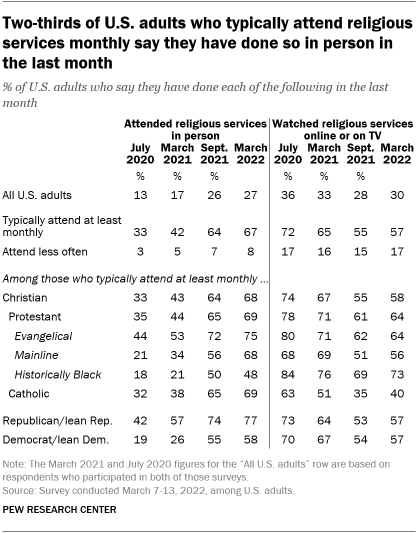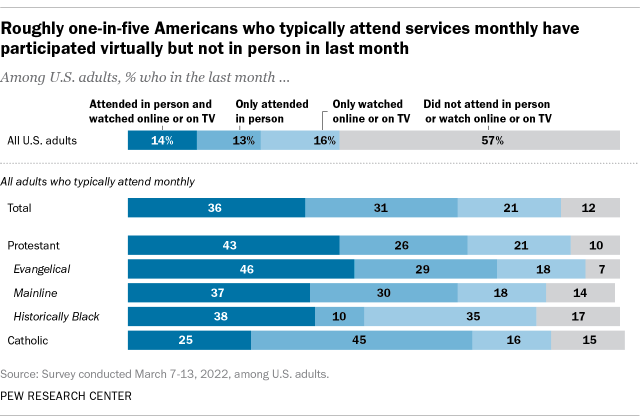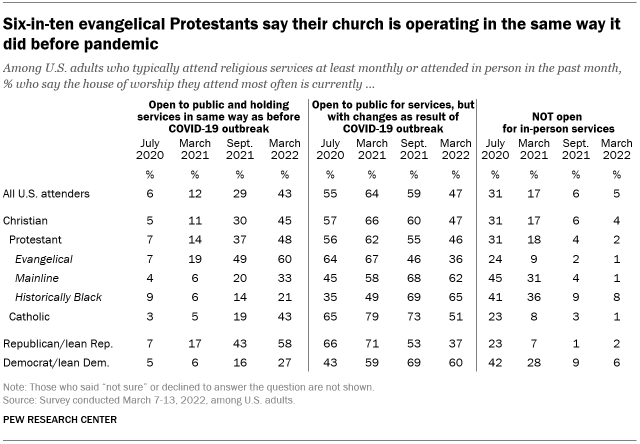Note: For a March 2023 analysis of religious attendance and the COVID-19 pandemic, read “How the Pandemic Has Affected Attendance at U.S. Religious Services.”
As COVID-19 cases continue to decline and pandemic restrictions are eased across the United States, churches and other houses of worship increasingly are holding services the way they did before the outbreak began, according to a new Pew Research Center survey. But there has not been a corresponding rise over the past six months in the share of Americans who are attending in-person services.

Among U.S. adults who say they attend religious services, 43% now report that their house of worship is currently open and holding services the same way it did before the COVID-19 outbreak – up 14 percentage points in the last six months and 31 points since last March. Meanwhile, 47% say their congregation is open but with modifications still in place due to the pandemic, such as mask requirements or social distancing.
Just 5% say their congregation is still completely closed to in-person worship, unchanged since September of last year (6%). In other words, the overall share of U.S. worshippers who say their congregation is open to in-person services has not increased over the last six months, but fewer people say their services include coronavirus-related precautions.
Pew Research Center conducted this study to help track how the coronavirus outbreak has affected religious worship in the United States. For this analysis, we surveyed 10,441 U.S. adults from March 7-13, 2022. Everyone who took part in this survey is a member of the Center’s American Trends Panel (ATP), an online survey panel that is recruited through national, random sampling of residential addresses, which gives nearly all U.S. adults a chance of selection. The survey is weighted to be representative of the U.S. adult population by gender, race, ethnicity, partisan affiliation, education and other categories. Read more about the ATP’s methodology.
We compared the results of the March ATP survey with three prior surveys conducted since the coronavirus outbreak. All four surveys (conducted in July 2020, March 2021, September 2021 and March 2022) asked some of the same questions about the operating status of panelists’ religious congregations and about their attendance at religious services. Here are the questions used for this analysis, along with responses, and its methodology.

The same survey shows that attendance at in-person services – which grew steadily from July 2020 through September 2021 – has plateaued, as has the share of adults watching religious services online or on TV.
In July 2020, roughly four months after COVID-19 upended life in America, 13% of U.S. adults reported having attended religious services in person during the previous month. That figure rose to 17% in March 2021 and then to 26% in September 2021, and now stands at 27%.
Over the same period, the share of Americans who say they have streamed religious services online or watched them on TV in the past month declined from 36% in July 2020 to 28% in September 2021 and is now 30%.
About a third of U.S. adults (32%) in the new March survey say they typically go to religious services at least once or twice a month. Of these self-described regular attenders, two-thirds (67%) report that they actually have attended physically (in person) in the last month, while 57% say they have watched services online or on TV during that period.
The survey’s questions about in-person and virtual attendance can be combined to provide a sense of how many people are watching services online instead of attending in person, and how many are watching online in addition to attending in person. The Center’s survey finds that among all adults who say they typically attend services at least monthly, 36% have both attended in person and watched services digitally in the last month, while three-in-ten (31%) say they have only attended in person but not watched online or on TV in the last month.
One-in-five (21%) may still be substituting virtual attendance for in-person attendance, saying they recently have watched religious services online or on TV but have not attended in person. Just 12% of self-described regular attenders report that they have neither gone in person nor watched services virtually in the last month.

Assessing the impact of the pandemic on religious service attendance remains difficult for two main reasons. One is that the ultimate course of the pandemic is still unclear. What appears, at this moment, to be a plateau in religious service attendance could be followed by a rise if the pandemic gradually recedes, or by a drop if a new, highly infectious coronavirus variant emerges.
The second reason for uncertainty is that, prior to the pandemic, Pew Research Center surveys did not clearly distinguish between physical attendance at religious services and virtual attendance. While religious congregations as a whole may have experienced a large drop in physical attendance during the pandemic, there’s good reason to believe that virtual attendance is much higher today than it was before the coronavirus outbreak began in early 2020. One piece of evidence is that, in a July 2020 survey, 18% of U.S. adults said that since the pandemic began, they had watched religious services online or on TV for the first time. Combining both forms of attendance, nearly nine-in-ten people who say they are regular attenders (88%) report that they have participated one way or the other in religious services in the past month.
In addition, the share of all U.S. adults who say they have either attended religious services in person or watched online or on TV (or both) in the past month (43%) is substantially greater than the share who say they typically attend religious services at least once or twice a month (32% among all March 2022 survey respondents). This suggests that people’s actual behavior may vary from month to month, or that some people may not think of online services when answering the question about their typical attendance.
The new study, like previous surveys, finds notable differences in attendance patterns across Christian subgroups. For example, Protestant churchgoers in the historically Black tradition stand out for being the Christian group most likely to have only watched religious services online or on TV in the last month, with about a third (35%) describing their behavior this way.
Indeed, while Black Americans are, on average, more religious than White and Hispanic Americans by a number of religious commitment measures, churchgoers in the historically Black Protestant tradition (48%) are substantially less likely than evangelical Protestants (75%), mainline Protestants (68%) and Catholics (69%) to say they have attended religious services in person in the last month. (Other surveys show that the pandemic has hit communities of color especially hard.)
Meanwhile, among those who typically attend religious services at least monthly, Protestants in the historically Black tradition (73%) are more likely than evangelical (64%) and mainline (56%) Protestants to say they have watched services virtually in the last month, and all of these groups are more likely than Catholics (40%) to say they have done so.
Mainline Protestant churchgoers stand out for rising rates of in-person attendance, with the share saying they have attended a service in the last month increasing by 12 points since September 2021 (from 56% to 68%).
Although the survey was conducted among Americans of all religious backgrounds, including Jews, Muslims, Buddhists and Hindus, it did not obtain enough respondents from non-Christian groups to report separately on their responses. Small subgroups of Christians are unable to be analyzed separately for the same reason.
When it comes to the operating status of congregations, a majority of evangelical Protestants who typically attend religious services at least monthly or say they attended in person in the past month (60%) say their church is open and holding services in the same way it did before the pandemic began. Evangelicals are significantly more likely than mainline Protestants (33%) and Catholics (43%) to say this is the case. Among Protestants in the historically Black tradition, just 21% say their congregation is open and operating normally, while roughly two-thirds (65%) say their church is open but with changes or restrictions still in place due to the pandemic.
Among religious attenders, the share of Republicans and Republican-leaning independents who say their house of worship is currently open and operating the way it did before the pandemic is roughly double the share of Democratic congregants who say the same (58% vs. 27%). Democrats (and Democratic leaners) who regularly attend religious services are much more likely than their Republican counterparts to report that their house of worship is open but operating with pandemic-induced changes in place (60% vs. 37%).
Republicans who typically attend religious services also are much more likely than Democrats in the same category to say they have attended religious services in person in the last month (77% vs. 58%). But members of both parties are equally likely to say they recently have watched services online or on TV (57% each).

Note: Here are the questions used for this analysis, along with responses, and its methodology.
